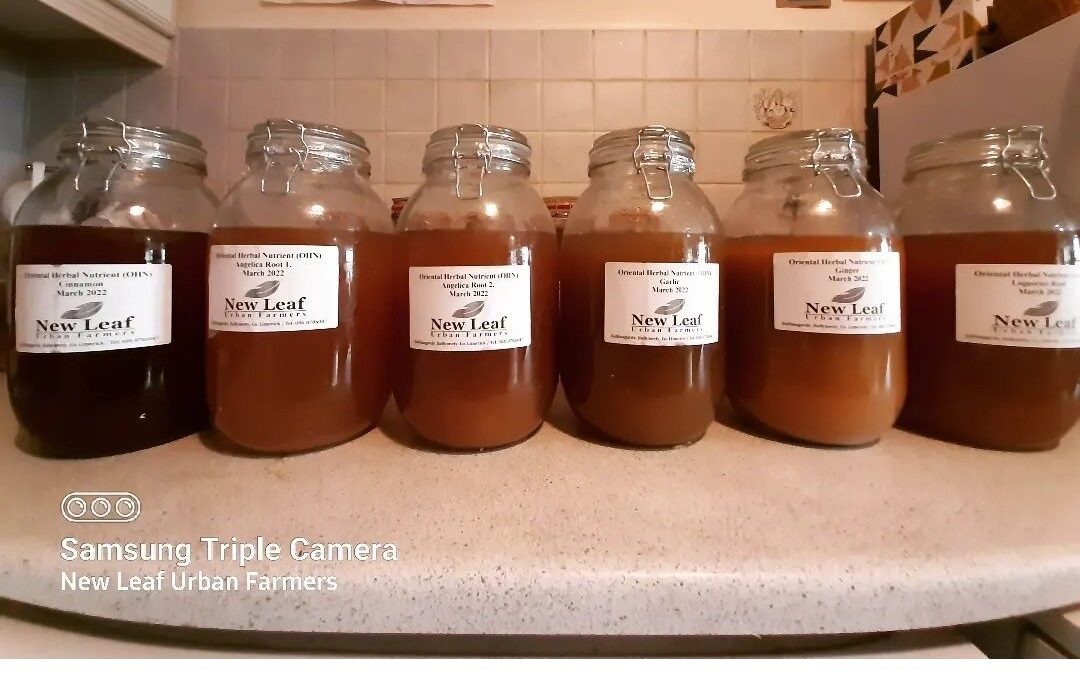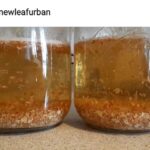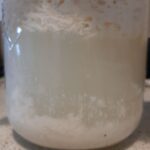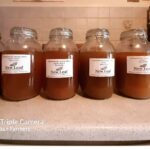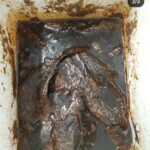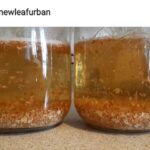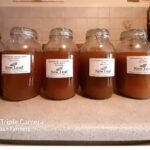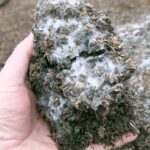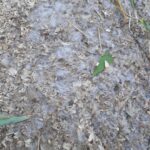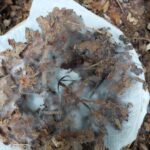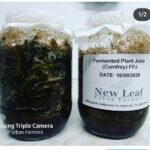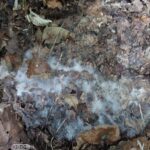I have been studying and using Korean Natural Farming (KNF) since late 2019. I was introduced to it by a friend of mine the year previously; but instead of changing my complete approach to growing vegetables, I decided to study the methodology first and see, as much as I could, the rationale behind it. So I began collecting seawater initially, then making several of the inputs and, finally during lock-down, collecting microbes. Now, in 2023, my market garden is run completely on KNF.
So what is KNF?
It began in the early 1960s by Cho Han-Kyu. He was a farmer who disliked how Korean farmers were adopting “Western farming techniques” which was leading to profound changes in their economic circumstances, as well as destroying the environment. He travelled to Japan and studied under three different natural farming teachers, who introduced him to the power of soil microbes, plant enzymes and the nutritive cycling of plants theory. From there, he adapted these teachings, as well as indigenous Korean practices to form KNF.
What makes this methodology unusual is that it does not just apply to vegetables, but also to fruit and nut production, pig, dairy and what Mr. Cho considers the “jewel in the crown”: poultry. You might have heard of the no-smell pig and poultry production houses. This all comes back to what underpins KNF, and that is soil microbes (with a special emphasis on fungal cultivation); they inhabit both the soil and the plants themselves from root to tip. Therefore, it is an holistic approach which begins with the soil and then applying certain inputs (outlined below) to the plants as they go through their nutritive cycling stages of growth. What I have found most challenging, and also profound, is how KNF forces you to study plants. Not under the microscope, not with a PhD or an expensive course costing thousands, but rather through observation. Observing your plants and understanding their needs as they grow and applying the right input at the right time. So think of it as a two-pronged approach: below the surface and above the surface of the soil.
IMOs (Indigenous Micro-Organisms).
These are soil microbes that live in our local area and have contributed to creating the environment that they live in. If we live in an area where man has applied conventional techniques or areas which are in poor health, then soil microbes can revitalise these areas over time. So what are the characteristics of IMOs?
*The ability to decompose complex organic materials: think animals, plants, excrement and so on. These are broken down and made available to be absorbed by plants. This is also true of inorganic materials.
*They act as catalysts through the production of enzymes, organic acids and antibiotics which plants are reliant on.
*They are the foundation of the ecosystem. IMOs are composed of bacteria and fungi which are then followed by nematodes, earthworms, moles and so on.
*They suppress diseases by nutrient cycling of trace minerals as well as being stronger and more adaptable than pathogenic microbes. In essence, strength through diversity.
So where are these IMOs and how do we collect them? Well, they are all around you. On your land, in your local woods or up in the hills or mountains. What we are looking for is a great diversity of microbes: the more diversity the better. We tend to search for microbes which are at a higher elevation than your farm. At higher elevations, microbes tend to be stronger because they face tougher conditions throughout the seasons. So when we are looking for microbes, we set traps in numerous places over the course of the seasons. It’s not always possible to get microbes at precise times of the year; rather we gather them when it is possible. For example, autumn is a great time of year, for me September/October is a prime time. But spring and late winter are good also. We want microbes that are active in all conditions so that when applied to the soil, they will be active in times of heavy rain or drought. We tend not to collect IMOs on land lower than one’s own land. The best of all is in broadleaf forests where trees are older and have long established symbiotic relationships with microbes. For me, that is my local wood. It is about 20 minutes away by car, but only about 6km as the crow flies.
We use white rice: we wash the rice and then use a rice cooker to parboil the rice so it is al dente. The rice is put in a wooden box (cedar or bamboo is recommended, but not plastic or cardboard) and filled up to two-thirds, then covered with a paper towel or rice paper. Then I look for old trees that have a south-facing aspect. From there, I peel back the leaves to reveal any mycelium. We look for thread-like hyphea. Once we find somewhere the mycelium is active we dig out a hole a couple of inches deep (The same size of the box/trap). Then we place the trap in the hole and use the excavated leaf mould to cover the sides of the box. Afterwards, We either place a tarp over the box or use fallen leaves and pile them high over the box. This keeps the paper towel dry. You can also gather other pieces of mycelium and place them on top of the paper towel which covers the box. After anything between five to ten days (depending on day/night temperatures, usually six to seven days), we collect the traps.
Cultivating IMOs
From the field we prepare the inoculated rice. We weigh the rice (it forms a rice cake-like hardness) and mix it with raw brown sugar or jaggery, with a 1:1 ratio. Then fill a glass or clay jar, cover with kitchen towel and leave in a warm, dark, dry place for one week or so. This allows the mix to ferment as such, then store between 1-15C. It can be stored for several years, although its potency does reduce over time. We call this IMO2.
*Next stage is to multiply or culture the IMO2s. We use a carbohydrate and a carbon source; the original recipe calls for wheat or rice bran. However it is expensive here in Ireland, so I use oats (porridge kind) and oat hulls which I get from a miller friend of mine. Basically, food and housing for the microbes. We mix in several inputs such as a pre-biotic Oriental herb nutrients (OHN), brown rice vinegar (BRV), fermented plant juice (FPJ), seawater (SW), fish amino acids (FAA) and some people use humic acid and/or calcium phosphate (WCP) to rainwater. After a week, the pile is finished (turned every day). It can be stored in the jute sacks out of direct light and extreme temperatures for several months. This stage is IMO3.
*The next stage is to mix my native soil with my pile of IMO3, 1:1 ratio. Again, using the same process as IMO3 with the inputs and moisture; turn every day and check temperatures – we do not want them to go over 50C, and I try to keep it under 44C. The higher temperatures will generate heat-loving microbes which is not what we are after. Again turn every day for about four or five days. The temperature of the pile will reduce over time to ambient temperature. This is IMO4.
*There is another stage which can be used for potting mixes. We call this IMO5 and just add a high nitrogen source and again make it like all the other stages. Manure is a good source; I don’t have animals so I just use my own compost I make on-site. You can add bone powders or shell such as crab for extra calcium. Leave for one to two weeks.
Inputs
OHN (Oriental Herbal Nutrient)
A tincture of five herbs; angelica gigas or sinensis, cinnamon bark, liquorice root, ginger and garlic. OHN is probably the most important and utilised input among the KNF suite. The herbs are fermented and then tinctured using a high strength alcohol (vodka) to stabilise and preserve them. They are extracted five times over the course of three months. We use it 1:1000 ratio. We store each herb separately until needed then mixed; angelica root is done twice, so six jars in total.
OHN revitalises plants, it acts like a steriliser and activates plant’s growth. OHN micronises over time which means we use it at lower ratios.
Fermented Plant Juice (FPJ)
Made from non-toxic, fast-growing and vigorous plants. We collect them in early morning when dew is on the plants as they are covered in lactic acid bacteria and yeasts. The chemical composition of plants changes from day to night, so we wish to collect plants before the sunrises to capture the chlorophylls, which have auxins present as well as the lactic acid bacteria and yeasts. All these are very useful (and plant available) for a plant’s development. Dropwort and mugwort are the original recipe, but comfrey and nettles are great local plants to use (fresh seaweed too). We take the growing tips only and ferment them in raw brown sugar at 1:1 ratio for about a week. Used at 1:500 ratio.
Fermented Fruit Juice (FFJ)
Very similar to FPJ but made with three types of fruit (we tend not to use critic fruit). Used to ripen fruit at reproductive stage. Used 1:500.
Lactic Acid Bacteria (LAB)
Powerful bacteria which are facultative in that they can operate in both aerobic and anaerobic conditions. They are resistant to temperature extremes, accelerate plant and root development and have the ability to increase the solubility of fertilisers. They also help neutralise ammonia gas in immature compost. Moreover, they help flocculate (form into small clumps) the soil. We make this from rice wash water (the milky water when washing white rice) left outside for a couple of days or inside if the temperatures are low. The rice wash water will attract lactic acid bacteria. We then add milk (unprocessed if possible) at 1:10 ratio until the milk has three layers (usually five to seven days); the middle layer is the LAB serum. The top is cheese, and a kind of sludge at the bottom. We extract the yellowish serum, filter and leave in fridge. Used 1:1000.
Brown Rice Vinegar (BRV)
BRV is an acid, but when consumed by plants, animals and humans it becomes alkaline. It contains phytic acid which is a great steriliser. It helps with calcium absorption. When applied to plants, it helps form a waxy layer on the leaves, which increases resistance to diseases and pests as well as accelerates reproductive growth. Since we use sugar in our ferments and IMO2 we use BRV as a buffer. Used 1:500.
Fish Amino Acid (FAA)
Made from blue fish waste, mackerel is a very good choice being abundant and relatively easy to source; herring, salmon and trout are also good choices. We ferment again in raw sugar at 1:1 ratio. It takes about a year to make a good batch, but can be used after three months. It smells fine, just like fish. It has very high protein levels meaning we use this as a nitrogen fertiliser; we use it also for making IMOs. We use it up to reproduction period, but for leafy greens it can be throughout the growth cycles. Mackerel FAA is very good at getting rid of mites and whitefly. Apply a couple of days before harvesting to ensure smell has gone, although it usually is gone within a day. Used 1:1000.
Water Soluble Calcium (WCA)
WCA is made from egg shells or oyster shells, roasted in a frying pan and then mixed with BRV at 1:10 ratio. The acetic acid reacts with the shells and solubilises the calcium. Used during change-over period as well as used for ripening and overgrowth in plants. Used 1:1000.
Water Soluble Calcium Phosphate (WCP)
Made from cow bones, sheep or pig; not poultry. Bones are charred like biochar until they are completely black throughout; then added with BRV for about seven to ten days (same as WCA). 1:10 ratio. Used for vegetative growth and cross-over period, when plants are overgrown and in poor weather conditions. Used 1:1000.
Water Soluble Potassium (WK)
Made the same way as WCP; but we use sunflower stalks (Jerusalem artichokes work too). Charred and left in water, this time for about seven to ten days. Used 1:1000.
Seawater & Fermented Seawater (FS)
Seawater has many minerals in it. We use the surface water (first inch or so) from the sea; I collect it at the beach). Deeper depths have higher concentration levels of salt and less microbes. We dilute at a 1:30 ratio with rainwater to provide a complete array of minerals to our crops. Used in maintenance solution as well as making IMOs. Fermented seawater is done by mixing rice-washed water (like when making LAB) mixed with FPJ. Great for increasing the sugar content of fruits when mixed with WCA. Fermented seawater needs to be used immediately
In Conclusion
This is a very general overview of KNF. Application of IMOs is usually done in autumn; but you can make liquid IMO (LIMO) and spray on fields or crops. This can be done when animals leave the pasture, or to help prevent diseases when the season turns in late June or early July with increased humidity levels. We usually foliar spray our inputs nutrients onto our crops. For example, the core solution is called “maintenance solution”, this is OHN, BRV, FPJ and then we mix with LAB, WCA, WCP, FAA and seawater. Again, it depends on the plant’s stage of growth and nutritional requirements. For leafy greens, we use maintenance solution and FAA; but if they overgrow we can leave out FAA and use WCP or WCA (or both alternately from week to week) to thicken the leaves and limit growth, thus strengthening tissue cells and preventing pest damage from aphids.
KNF does not require expensive investment both in terms of technology or courses. Although courses are available, one can study it for oneself. It is open-source and freely available on the internet. There are peer-reviewed documents from third-level institutions being published and there are a lot of how-to-do videos on Youtube. What I like about it is that if you have neighbours or other people in your locale, you can create your own community to help share inputs such as OHN, WCA, WCP and so on. But it is also wise to remember our ancestors had various versions of this in their own right across the world. Think of terra preta soils in the Amazon, or the black soils of western and central Africa. Indigenous knowledge and practices are probably the most profound, as they have been borne out of necessity and a very close affiliation to the land. We are just removed from that.
In the three seasons or so since I began using KNF, my pest and disease issues have declined to such a level that I do not have many issues as such. I stopped rotating my crops about four years ago; I know this may seem absurd, but I can only tell you what I have experienced and observed. My soil was always very heavy clay with about four inches of topsoil. Flooding was an issue every year, as were leather jackets, aphids and greenfly. Weeds were a perennial issue, but no tilling helped a lot in this regard, as did using compost on the beds every autumn. IMOs were applied in stages across the market garden over the last three seasons. Each year I dug similar areas of the market garden to check how the soil has changed. I have found that the clay has become permeated with worm activity, as well as noticing the discolouration of the grey clay to more like milk chocolate at lower levels and very dark at upper levels. The clay layer has become more crumbly (if that makes sense) akin to making short crust pastry prior to baking. There are no flooding issues now and in one area which was significant, water does pool (if very heavy rain occurs) but it is gone within an hour or two. In 2018, my soil was very dry during the summer and started cracking and lifting, a visible separation of layers between the humus layer and the clay layer. Last season (2022) we had dry soil but only in the top inch or two. This was rectified once it began to rain.
The soil under foot is spongy, similar to a forest floor. Leather jackets are now gone and aphids, although still present (they are a food source after all) are in very low concentrations. Last year was my first year of abundant ladybirds, as well as increasing number of hoverflies and butterflies. I know this is anecdotal evidence but I can only speak of how my soil has changed over this period.
On the production side, my leafy greens are healthier with little to no lettuce drop, and I am getting an extra cut which means less seed and less transplanting.
KNF provides the farmer with the tools to be truly independent with regard to inputs and also to remediate and maintain the soil over time. It is not an immediate transformation, rather it is a gentle and elegant methodology which can be used at scale and across farming sectors.
Written by Kevin Wallace
- FAA
- FPJ
(The views and ideas expressed in this article are those of the contributing author and may not reflect the views or ideas of the Organic Growers of Ireland)

